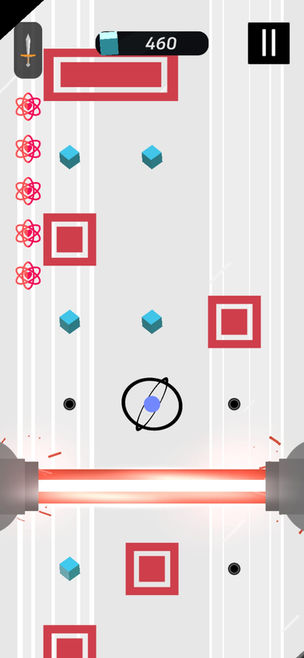OVERVIEW
PROJECT BREAKDOWN
Project duration: 2 months (half time)
Made with Unity
Team: 4 Game Designers - 3 Gameplay Programmers
Genre: Mobile Roguelite
PROJECT CONDITIONS
The main point of this project was to make an F2P game on mobile with an economic system.
During this project, I had multiple roles, such as:
-
Game Designer: Concept | 3C | Balancing
-
Level Designer: World Structure | Procedural Design | Situation Design
LEVEL DESIGN INTENTIONS
Short experience.
Each level lasts 1min 30 and each world contains 4 levels.
Seamless difficulty progression.
The difficulty is managed by various adaptable parameters.
Creates identity.
Even with a procedural generation, levels and worlds need to have a bit of identity.
BRICKS CREATED
Obstacles

Enemies
Enemies have three types (Low; Mid; High). Each form has different base health points (2; 4; 6). Their health rises as the player progresses.

Lasers
One of the design challenges was to push players to use verticality as well. Lasers therefore force the player to change lines.

Bosses
The bosses stay in one of the possible player locations. After being hit, they teleport into another location. They are founded in every final level of each world.

Walls
They are similar to the enemies but with 1.5 times their life. The goal is to avoid them rather than break them.
Collectibles

Soft Currency

Weapon Switch
WORLD STRUCTURE
Boss fight
Classic level

Classic level
Key Level
Classic levels & Key levels
Classic levels and Key levels are levels that end after surpassing several situations. Key levels add "Key Situations". These situations are more unique and are intended to vary the experience.
Boss fights
Boss fights are levels that end after killing the boss otherwise they will continue indefinitely.
LEVEL GENERATION
The level generation takes into account various parameters in its procedure:
Intensity
First, the level will select one of the three intensity curves. It will follow this curve to pick each situation with a corresponding intensity.
A specific curve was made for the Key Levels. In this curve, the intensity "-1" corresponds to the Key Event.

Number of situations
Depending on the player’s world, the number of situations will be adapted by following another curve.
I had set a limit number to avoid impossible situations.

Obstacle's life

After 4 worlds the player passes a gap.
At every gap, the life of Walls and Enemies will increase. This increase is intended to follow the reinforcement of the player’s weapons.
Ticks
A tick represents the moment when obstacles come down a line. Depending on the player’s current world, the time between each tick is gradually reduced.
Prototype on Sheets
Before having the functional system on Unity, I quickly prototyped on Google Sheets the level generation.
Note: The first situation is shown at the top and the last one at the bottom. Each situation reads from bottom to top.

LEVEL SITUATIONS
As said before, levels choose situations from a database containing 300+ different patterns. Thanks to the concept, it was easy to create patterns that were both different and similar.
Situation length
Situations range in length from a minimum of 2 lines to a maximum of 7 lines. The vast majority of situations have a length of 3-4 lines. It also allowed me to ensure the duration of levels thanks to ticks.
Intensity
To determine the intensity of each situation, I have established a guideline based on the movements required:
-
Intensity 1: spaced and does not necessarily require movement
-
Intensity 2: close and does not necessarily require movement
-
Intensity 3: spaced but requires movement
-
Intensity 4: request to go to the opposite column
-
Intensity 5: more info than 4 OR precise movement avoidable via enemy
-
Intensity 6: precise movement
-
Intensity 7: precise path
-
Intensity 8: request to go to the opposite column and precise path once
-
Intensity 9: request to go to the opposite column and precise path several times
Depending on the intensity, the type of the enemies changes:
-
Low: Intensity 1 to 3
-
Mid: Intensity 4 to 6
-
High: Intensity 7 to 9
POST MORTEM
This project was the second time I was working with gameplay programmers. it went very well, we managed to have healthy and constant communication. Thus, we were able to correctly establish the scope of the game
It was my first time designing a mobile game. We managed to create a game that works well on mobile.
I am proud of the game, it has almost no bugs, it is well polished and the levels are nice to play.
However, the replayability is not perfect. At the end of several worlds, the levels begin to be repetitive. The effects of the weapons do not change the way of approaching the fights, which adds repetitiveness.













